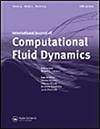Evaluation Method for the Reasonableness of Countermeasures for Defective Products in the Negative-Pressure Molding Mechanism
IF 1.3
4区 工程技术
Q4 MECHANICS
International Journal of Computational Fluid Dynamics
Pub Date : 2022-10-21
DOI:10.1080/10618562.2023.2192035
引用次数: 1
Abstract
We propose a new digital evaluation model for the negative-pressure molding mechanism, which is used to verify the feasibility of improvement measures for quality problem of the pad. The gas–solid flow in the negative pressure molding system facing the pad of diapers at the molding surface under different outlet pressures is studied using CFD-DEM bidirectional coupling simulation method. Aiming at the concentration of velocity/pressure values in the molding defect region, the uniformity coefficient is used as an important evaluation index to reflect the molding quality, and the parameters are optimised for the velocity and pressure uniformity of the gas phase in the molding defect region. For the fine flocculent discrete element, the parameter calibration is carried out, and the percentage of solid phase bearing at the screen is used as a reference index to further verify the feasibility of the improvement scheme. Finally, the model is applied to an improvement example, the results show that the molding defects of the cotton core layer are related to the velocity distribution of the molding surface. The molding quality can be significantly improved by setting a retaining ring at the outlet of the wind barn. The speed uniformity coefficient is improved by 44.2% when the retaining ring thickness s = 140 mm, inner diameter d = 1000 mm, and the relative position l = 0 mm. The molding quality has been significantly improved.负压成型机构不良品对策合理性评价方法
提出了一种新的负压成型机构的数字化评价模型,用于验证垫块质量问题改进措施的可行性。采用CFD-DEM双向耦合仿真方法,研究了不同出口压力下,面向纸尿裤垫的负压成型系统中成型面气固流动。针对速度/压力值在成型缺陷区域集中的情况,将均匀性系数作为反映成型质量的重要评价指标,针对成型缺陷区域气相速度和压力均匀性进行了参数优化。对细絮体离散元进行了参数标定,并以筛处固相承载百分率作为参考指标,进一步验证改进方案的可行性。最后,将该模型应用于一个改进实例,结果表明:棉芯层的成型缺陷与成型表面的速度分布有关。通过在风仓出口设置挡圈,可显著提高成型质量。当挡圈厚度s = 140 mm,内径d = 1000 mm,相对位置l = 0 mm时,速度均匀系数提高44.2%。成型质量明显提高。
本文章由计算机程序翻译,如有差异,请以英文原文为准。
求助全文
约1分钟内获得全文
求助全文
来源期刊
CiteScore
2.70
自引率
7.70%
发文量
25
审稿时长
3 months
期刊介绍:
The International Journal of Computational Fluid Dynamics publishes innovative CFD research, both fundamental and applied, with applications in a wide variety of fields.
The Journal emphasizes accurate predictive tools for 3D flow analysis and design, and those promoting a deeper understanding of the physics of 3D fluid motion. Relevant and innovative practical and industrial 3D applications, as well as those of an interdisciplinary nature, are encouraged.

 求助内容:
求助内容: 应助结果提醒方式:
应助结果提醒方式:


